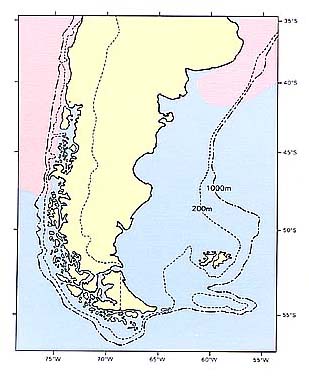サンマ科
- HOME
- デジタル図鑑
- パタゴニア海域の重要水族
- 硬骨魚綱 ダツ目 サンマ科
サンマ科(Scomberesocidae)

51 ハシナガサンマ(Hashinaga-sanma)
Scomberesox saurus (Walbaum, 1792)
Agujilla (Ch.); Aguja (Arg., Urg.); Paparda (Sp.); Delphine (Por.); Saury, Skipper, Billfish, Brincador (Cuba)
特 徴:
背鰭9〜11軟条,5〜6副鰭,臀鰭10〜13軟条,5〜7副鰭,胸鰭13〜14軟条,腹鰭13〜14軟条,側線鱗数130〜145,鰓条骨数13,鰓耙数6〜7+42〜45=49〜52。頭長は体長の34.4〜35.9%(サンマ類の体長は眼窩後縁と下尾骨板の後縁の距離,Hubbs and Wisner, 1980),眼径は4.1〜4.3%,体高は11.7〜12.4%,吻長は18.3〜21.9%,両眼間隔は4.7〜5.5%,上顎長は16.7〜18.1%,尾柄高は2.7〜3.0%,眼窩後縁〜背鰭起部は65.0〜71.2%,眼窩後縁〜胸鰭起部は8.5〜9.4%,眼窩後縁〜腹鰭起部は51.0〜52.5%,眼窩後縁〜肛門は64.1〜65.9%,眼窩後縁〜臀鰭起部は66.2〜67.7%。体は側扁して延長する。両顎は前方に著しく長く伸び,先端に小肉質突起を有する弱い細長い嘴を形成する。下顎の方が上顎よりやや前方に突出する。上顎後端部は涙骨におおわれ,眼の前縁にはるかに達しない。細長い絨毛状歯が両顎にある。第1鰓弓の上枝上の鰓耙は短いコブ状,下枝上の鰓耙は細長い。胸鰭は短く,その位置は高い。背鰭と臀鰭は体の後方に位置し,両者の後方に数個ずつの副鰭を有する。腹鰭も小さく,眼窩後縁と尾叉とのほぼ中間位置する。側線は単線で腹側に著しく近く腹縁と平行に走る。背部は青黒色で,腹部は銀白色。
分 布:
南半球と北大西洋の温・寒海に分布する。
備 考:
Hubbs and Wisner (1980)は本種を2亜種に分けた:Scomberesox saurus saurus (Walbaum, 1792)-北大西洋;Scomberesox saurus scombroides (Richardson, 1842)-南半球。産卵は外洋の温帯域で行われる。プランクトン食性で温帯域の産卵海域から寒海域へ索餌回遊を行う(Wisner, 1981)。
(中村 泉)
Material examined:
7 from Chile (241.5-275.9 mm SL), FAKU 108623-108629.
Description:
D 9-11+5-6; A 10-13+5-7; P1 13-14; P2 13-14; LLS 130-145; BR 13; GR 6-7+42-45=49-52.
HL 34.4-35.9% of BL (Body length is defined as the distance from the posterior margin of the orbit, PO, to the end of hypural plate, according to Hubbs and Wisner, 1980); ED 4.1-4.3; BD 11.7-12.4; SN 18.3-21.9; IO 4.7-5.5; UJ 16.7-18.1; CP 2.7-3.0; PO-D 65.0-71.2; PO-P1 8.5-9.4: PO-P2 51.0-52.5; PO An 64.1-65.9; PO-A 66.2-67.7.
Body elongate and fairly compressed. Both jaws anteriorly extended, forming slender and fragile beak, lower jaw slightly longer than upper and bluntly tipped with soft tissue. Posterior end of upper jaw covered by lachrymal and situated far anterior to eye. Teeth villiform, in narrow bands extending almost to tip on each jaw. Gill-rakers on upper arches short and knob-like, on lower arches slender. Pectoral fin short and situated rather high in position. Dorsal and anal fins situated posteriorly, each followed by several finlets posterior to them. Pelvic fins situated nearly midway between posterior margin of orbit and caudal fork. Lateral line closely following ventral profile.
Distribution:
Temperate and cold waters of the Southern Hemisphere and the North Atlantic.
Remarks:
Hubbs and Wisner (1980) separated this species into two subspecies: Scomberesox saurus saurus (Walbaum, 1792) in the North Atlantic and Scomberesox saurus scombroides (Richardson, 1842) in the Southern Hemisphere. Spawning takes place mainly in the open ocean, in warm-temperate water. They feed on small planktonic forms, and perform feeding migrations from spawing areas to cool-temperate, plankton-rich waters (Wisner, 1981).
(Izumi NAKAMURA)

Distribution of Scomberesox saurus in Patagonia.

Lateral view of head with elongate jaws.
- 1